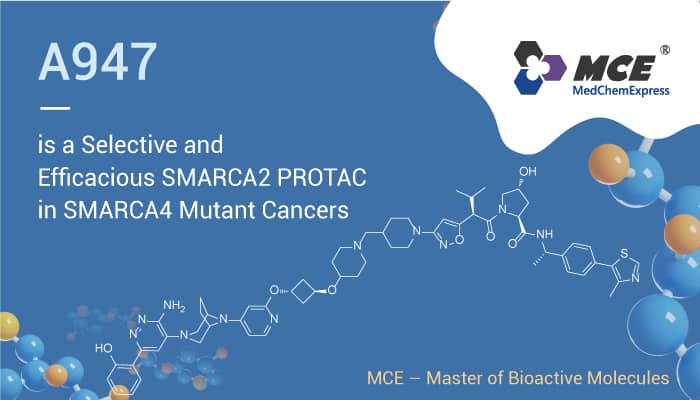SWI/SNF complex has two important ATP-dependent helicases, SMARCA2 and SMARCA4. In fact, SMARCA2 and SMARCA4 share strong protein sequence homology. But SWI/SNF helicase SMARCA4 is frequently mutated in cancer. The inactivation of SMARCA4 results in a cellular dependence on SMARCA2. Thus, SMARCA2 becomes an attractive synthetic lethal target. Proteolysis targeting chimeras (PROTACs) is an emerging therapeutic modality. PROTACs can induce the degradation of target proteins by recruiting the protein of interest to an E3 ubiquitin ligase. Furthermore, lead the subsequent tagging of the protein to achieve proteasome-mediated destruction through the addition of ubiquitin. The multi-subunit switch/sucrose non-fermentable (SWI/SNF or BAF) complex can facilitate the remodeling of chromatin to regulate key cellular processes including transcriptional regulation and DNA repair.
A947 is a potent and selective SMARCA2 PROTAC.

A947 is a potent and moderately selective SMARCA2 degrader. In vitro, A947 can inhibit the growth and proliferation of SMARCA4-mutant nonsmall-cell lung cancer (NSCLC) cells. It can potentially degrade SMARCA2 in SW1573 cells with a DC50 value of 39 pM. Meanwhile, A947 has a binding affinity to the SMARCA2 and SMARCA4 bromodomains with Kd values of 93 nM and 65 nM, respectively. And A947 can mediate ubiquitination and degradation of SMARCA2/4. Furthermore, A947 also has active in SMARCA4-mutant NSCLC xenograft models in vivo. The I.V. administration of A947 resulted in a rapid reduction in tumor SMARCA2 protein levels and achieved maximal target gene suppression by 96 h post-dose. A947 also exhibits a significant decrease in tumor growth in two different SMARCA4mut lung cancer xenograft models, HCC515 and HCC2302.
In a word, A947 is a potent and selective SMARCA2 PROTAC. It is a strategy to use otherwise inert ligands with equivalent binding affinities to the bromodomains of SMARCA2/4 and the 5th bromodomain of PBRM1 to develop a VHL-based PROTAC– A947.
Reference
[1] Jennifer Cantley, et al. Nat Commun. 2022 Nov 10;13(1):6814.